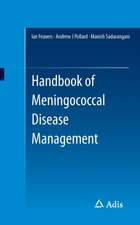Human Immunodeficiency Virus type 1 (HIV-1) and Breastfeeding: Science, Research Advances, and Policy: Advances in Experimental Medicine and Biology, cartea 743
Editat de Athena P. Kourtis, Marc Bulterysen Limba Engleză Hardback – 28 mar 2012
In this book, expert HIV researchers critically review every aspect of this highly evolving and topical subject. The opening chapters deal with the epidemiology, global magnitude and biologic mechanisms of HIV-1 transmission from mother to child through breastfeeding and include considerations of the virus (quantity, compartments, characteristics) and the host (genetic, immunity-innate, cellular, humoral). The effects of breastfeeding on the HIV-infected mother’s health and nutritional status, and the social and cultural issues associated with the practice of breastfeeding are also discussed. The next few chapters provide cutting-edge reviews of the latest approaches to prevention of HIV transmission to the infant through breastfeeding, including antiretroviral strategies, nutritional and immune-based approaches, and treatment of expressed breast milk. The remaining chapters provide a fascinating review of the many iterations this subject has received, as reflected in the several different sets of guidelines for infant feeding by HIV-infected mothers issued by the World Health Organization, and a debate by leading scientists on whether HIV-infected mothers should breastfeed their infants-in resource-limited and in resource-rich settings. A comprehensive overview of the current state of implementing the new evidence for prevention of breastfeeding transmission of HIV all over the world is also presented.
Essential reading for the many disciplines of scientists and clinicians working on HIV/AIDS and other retroviruses, pediatricians, obstetricians/gynecologists, as well as all health-care professionals interested in expanding their understanding on the subject.
| Toate formatele și edițiile | Preț | Express |
|---|---|---|
| Paperback (1) | 1101.00 lei 6-8 săpt. | |
| Springer – 23 aug 2016 | 1101.00 lei 6-8 săpt. | |
| Hardback (1) | 1106.69 lei 6-8 săpt. | |
| Springer – 28 mar 2012 | 1106.69 lei 6-8 săpt. |
Din seria Advances in Experimental Medicine and Biology
- 9%
 Preț: 719.56 lei
Preț: 719.56 lei - 5%
 Preț: 717.20 lei
Preț: 717.20 lei - 20%
 Preț: 691.93 lei
Preț: 691.93 lei - 5%
 Preț: 715.71 lei
Preț: 715.71 lei - 5%
 Preț: 1113.83 lei
Preț: 1113.83 lei - 5%
 Preț: 1031.00 lei
Preț: 1031.00 lei - 15%
 Preț: 640.24 lei
Preț: 640.24 lei - 5%
 Preț: 717.00 lei
Preț: 717.00 lei - 5%
 Preț: 820.42 lei
Preț: 820.42 lei - 5%
 Preț: 717.00 lei
Preț: 717.00 lei - 5%
 Preț: 715.35 lei
Preț: 715.35 lei - 5%
 Preț: 716.28 lei
Preț: 716.28 lei - 5%
 Preț: 716.28 lei
Preț: 716.28 lei - 15%
 Preț: 641.38 lei
Preț: 641.38 lei - 20%
 Preț: 1161.71 lei
Preț: 1161.71 lei - 5%
 Preț: 1170.51 lei
Preț: 1170.51 lei - 18%
 Preț: 1119.87 lei
Preț: 1119.87 lei - 5%
 Preț: 1288.48 lei
Preț: 1288.48 lei - 5%
 Preț: 1164.67 lei
Preț: 1164.67 lei - 5%
 Preț: 1101.73 lei
Preț: 1101.73 lei - 18%
 Preț: 1123.67 lei
Preț: 1123.67 lei - 5%
 Preț: 1435.64 lei
Preț: 1435.64 lei - 20%
 Preț: 1044.10 lei
Preț: 1044.10 lei - 18%
 Preț: 946.39 lei
Preț: 946.39 lei - 5%
 Preț: 292.57 lei
Preț: 292.57 lei - 18%
 Preț: 957.62 lei
Preț: 957.62 lei - 18%
 Preț: 1235.76 lei
Preț: 1235.76 lei - 5%
 Preț: 1231.55 lei
Preț: 1231.55 lei - 5%
 Preț: 1292.30 lei
Preț: 1292.30 lei - 5%
 Preț: 1102.10 lei
Preț: 1102.10 lei - 18%
 Preț: 1132.81 lei
Preț: 1132.81 lei - 5%
 Preț: 1165.19 lei
Preț: 1165.19 lei - 5%
 Preț: 1418.48 lei
Preț: 1418.48 lei - 5%
 Preț: 1305.63 lei
Preț: 1305.63 lei - 18%
 Preț: 1417.72 lei
Preț: 1417.72 lei - 18%
 Preț: 1412.99 lei
Preț: 1412.99 lei - 24%
 Preț: 806.15 lei
Preț: 806.15 lei - 18%
 Preț: 1243.29 lei
Preț: 1243.29 lei - 5%
 Preț: 1429.44 lei
Preț: 1429.44 lei - 5%
 Preț: 1618.70 lei
Preț: 1618.70 lei - 5%
 Preț: 1305.12 lei
Preț: 1305.12 lei - 18%
 Preț: 1124.92 lei
Preț: 1124.92 lei - 5%
 Preț: 1097.54 lei
Preț: 1097.54 lei - 15%
 Preț: 649.87 lei
Preț: 649.87 lei - 5%
 Preț: 1097.54 lei
Preț: 1097.54 lei - 18%
 Preț: 945.79 lei
Preț: 945.79 lei - 5%
 Preț: 1123.13 lei
Preț: 1123.13 lei - 20%
 Preț: 816.43 lei
Preț: 816.43 lei
Preț: 1106.69 lei
Preț vechi: 1164.93 lei
-5% Nou
Puncte Express: 1660
Preț estimativ în valută:
211.81€ • 220.27$ • 177.24£
211.81€ • 220.27$ • 177.24£
Carte tipărită la comandă
Livrare economică 14-28 martie
Preluare comenzi: 021 569.72.76
Specificații
ISBN-13: 9781461422501
ISBN-10: 1461422507
Pagini: 336
Ilustrații: XVII, 315 p.
Dimensiuni: 178 x 254 x 24 mm
Greutate: 0.73 kg
Ediția:2012
Editura: Springer
Colecția Springer
Seria Advances in Experimental Medicine and Biology
Locul publicării:New York, NY, United States
ISBN-10: 1461422507
Pagini: 336
Ilustrații: XVII, 315 p.
Dimensiuni: 178 x 254 x 24 mm
Greutate: 0.73 kg
Ediția:2012
Editura: Springer
Colecția Springer
Seria Advances in Experimental Medicine and Biology
Locul publicării:New York, NY, United States
Public țintă
ResearchCuprins
Breastfeeding and transmission of HIV-1: Epidemiology and Global Magnitude.- Breastfeeding and Transmission of viruses other than HIV-1.- Breastfeeding among HIV-1-infected women: Maternal health outcomes and social repercussions.- Virologic determinants of breast milk transmission of HIV-1.- HIV-1 resistance to antiretroviral agents: Relevance to mothers and infants in the breastfeeding setting.- Animal models of HIV transmission through breastfeeding and pediatric HIV infection.- Antiretroviral pharmacology in breast milk.- HIV-1 diagnosis of the breastfed infant.- The immune system of breast milk: antimicrobial and anti-inflammatory properties.- Humoral /mucosal/innate immunity in the breast milk in the context of HIV-1 infection.- Cellular immunity in breast milk: Implications for Postnatal Transmission of HIV-1 to the infant.- Antiretroviral drugs during breastfeeding for the prevention of postnatal transmission of HIV-1.- Immune Approaches for the prevention of breast milktransmission of HIV-1.- Non-antiretroviral approaches to prevention of breast milk transmission of HIV-1: Exclusive breastfeeding, early weaning, treatment of expressed breast milk.- Breast milk micronutrients and mother-to-child transmission of HIV-1.- Historical perspective of African-based research on HIV-1 transmission through breastfeeding: The Malawi experience.- Breastfeeding and HIV infection in China.- The role of the President’s Emergency Plan for AIDS Relief (PEPFAR) in infant and young child feeding guideline development and program implementation.- Should women with HIV-1 infection breastfeed their infants? Balancing the scientific evidence, ethical issues and costs-policy considerations.- HIV-1 and Breastfeeding in the United States.- Epilogue. The future of breastfeeding in the face of HIV-1 infection: Science and Policy.
Recenzii
From the reviews:
“The purpose is to convey recent information about HIV-1 transmission by breastfeeding, the virology and immunology around breastfeeding … and the public health implications of policy recommendations and research on HIV-infected women. … The book is most appropriate for academic researchers and clinicians, but some sections that are summaries of the known data would be relevant for general practitioners and medical residents. … I would recommend this as an excellent resource for what is known about the field of HIV-1 and breastfeeding.” (Natalie M. Neu, Doody’s Review Service, September, 2012)
“The purpose is to convey recent information about HIV-1 transmission by breastfeeding, the virology and immunology around breastfeeding … and the public health implications of policy recommendations and research on HIV-infected women. … The book is most appropriate for academic researchers and clinicians, but some sections that are summaries of the known data would be relevant for general practitioners and medical residents. … I would recommend this as an excellent resource for what is known about the field of HIV-1 and breastfeeding.” (Natalie M. Neu, Doody’s Review Service, September, 2012)
Caracteristici
Presents the scope of HIV transmission from mother to infant through breast milk Includes new discoveries of mucosal and innate immunity Gives a current look at international research that attempts to balance HIV transmission prevention with retaining breast milk’s nutritional and immunologic benefits














